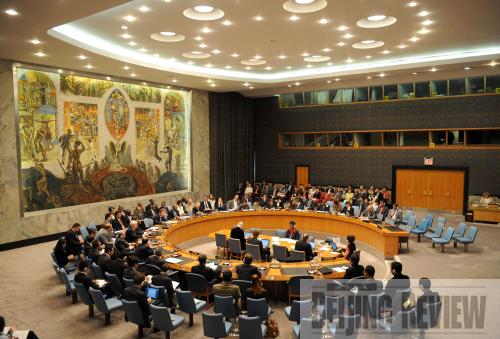|
 |
|
THE MYANMAR ROUNDTABLE: The UN Security Council holds a public meeting on July 13 at UN headquarters in New York. UN Secretary General Ban Ki-moon briefed the meeting about his trip to Myanmar in early July (GU XINRONG) |
Recently, as rumors of Myanmar's "nuclear plan" began to swirl in the Western media, even U.S. Secretary of State Hillary Clinton voiced concern over the country's alleged nuclear ambition. But it is questionable that an impoverished country like Myanmar could produce the atomic bomb in the short term in the first place. So what's behind the spread of the rumors?
Media fabrications
Over the years, the international press corps has already played up Myanmar's "nuclear plan," reporting that Myanmar, also known as Burma in the West, has acquired nuclear technology and nuclear weapons from North Korea. But more recently, nuclear proliferation concerns regarding North Korea and Iran have become bigger hot-button issues.
Now once again, however, it's Myanmar's turn.
The Sydney Morning Herald, for example, broke the news on August 1 which said, with assistance from North Korea, Myanmar had embarked on a clandestine nuclear project aiming to acquire its first atomic bomb within five years. It further alleged that Myanmar has been providing Pyongyang with enriched uranium in exchange for nuclear technology.
Then, on August 3, a Russian newspaper, quoting exiled Myanmar scholars, said the number of Myanmar's nuclear experts would reach 1,000 by the year 2012. Thanks to these media reports, the Myanmar nuclear issue has become the focus of international media attention.
The U.S. Government has since exploited these rumors, trying to disingenuously "arrange" a Myanmar nuclear project. Last month, in a notable instance, Hillary Clinton raised the specter of closer North Korea-Myanmar collaboration in developing nuclear weapons as a dangerous precedent during her visit to Thailand for the Regional Forum of the Association of Southeast Asian Nations (ASEAN).
Moreover, she voiced concern that the collaboration would endanger not just neighboring countries but also regional stability.
Kurt Campbell, U.S. Assistant Secretary of State for East Asia and Pacific Affairs, has also speculated that Myanmar reinforced its cooperation with North Korea for the express purpose of obtaining a nuclear weapon.
Underfinanced, unrealistic
Myanmar pursued a nuclear plan for the first time in 1956, but the plan was abandoned with the ascent of the U Ne Win military government six years later.
More recent efforts by Myanmar to build a nuclear reactor, this time with Russia's help, foundered as well. Initially, Moscow agreed to help Myanmar establish a nuclear studies center, including a nuclear reactor, in 2002. But the program was shelved the following year because of severe financial problems. It was not until 2007 that Myanmar and Russia signed an agreement to restart the program with the participation of Russia's State Atomic Energy Corporation.
Andrew Selth, an Australian academic and military expert, said the construction of the nuclear reactor had made little progress, owing to lack of funds. Indeed, Myanmar's nuclear program remains in its infancy due to financial and technical difficulties. Thus, it is highly unlikely that Myanmar will fulfill its nuclear ambitions any time soon.
In fact, due to its backward economy, Myanmar can hardly get enough funds for a nuclear project at all. Being one of world's poorest nations, Myanmar has suffered from decades of economic stagnation and political isolation. Last year, its gross domestic product was only $27.18 billion.
With a massive external debt of $6.7 billion and limited foreign exchange reserves of $3.6 billion, there is no way such an undeveloped country could afford the high costs of a nuclear project.
In addition, as the nuclear reactor program with Russia has not made any progress so far, it has provided scarce technical and material support for producing nuclear weapons. Besides, with the orientation of academic research, the Moscow Institute of Physics and Technology cannot turn Myanmar's technicians into nuclear experts.
Furthermore, Myanmar signed a comprehensive safeguards agreement with the International Atomic Energy Agency (IAEA) in 1995. Thus, under the tight regulations of the IAEA, it will be no secret should Myanmar decide to enrich plutonium with a nuclear reactor to produce nuclear weapons.
In fact, U.S. intelligence agencies have no evidence linking Myanmar to nuclear weapons, nor have IAEA officials made any comments to date on the fresh allegations.
But Selth has said that Myanmar would probably take a risk in acquiring nuclear weapons in order to enhance its international status as well as to increase its bargaining chips with the international community.
A defector from Myanmar has also said that a secret nuclear reactor is being constructed with North Korea's aid in a mountain near Naung Laing in Myanmar's north. The country, the defector added, is also exploiting two new uranium mines. However, with no serious evidence, it is difficult to tell if this is credible or not.
True intentions
There are several issues at play here. First, one agenda clearly exists to sever North Korea's economic and trade contact with Southeast Asia, as well as to pressure China.
| 